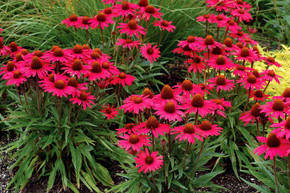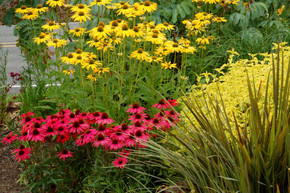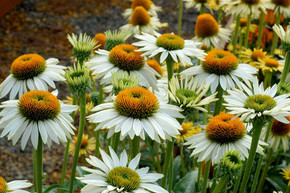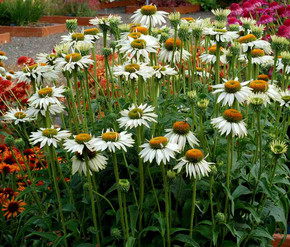
Echinacea pallida - PALE PURPLE CONEFLOWER
Long-lived perennial with a tap root, slender habitus, and narrow hairy leaves. Rosy-pink (sometimes more or less pale) flower with drooping petals and orange-greenish centers. Heat, humidity, and drought tolerant perennial. Flowers 2 to 4 weeks earlier than purple cone flower (Echinacea purpurea). The flowers can be slightly fragrant.
Important medicinal plant used by Native American cultures and in Western medicine - it is used to prevent and treat the common cold, flu, and upper respiratory tract infections. It is also used to increase general immune system function and treat urinary tract infections.
Due to it’s natural look, it's best to plant several plants or masses in somewhat natural-looking flowers beds, drier prairie plantings or use it for naturalizing. Looks great when combined with fine flowering grasses - Stipa tenuissima or Sporobolus heterolepis, for example!
For other good perennial combinations, add native perennials like Artemisia ludoviciana, Agastache (‘Blue Fortune’ , A. nepetoides), Asclepias tuberosa, Baptisia, Callirhoe, Eryngium juccifolium, Penstemon, Pycnanthemum, Liatris, Silphium terenbinthinaceum or bigger grasses like Panicum virgatum. This Echinacea looks good when combined with plants that remind of thistles, such as these non-native perennials: any Eryngium (E. planum, E. giganteum,…), Echinops, Knautia macedonica, but also with Geranium sanquineum, Perovskia or Salvia nemorosa.
Blooming Time: main flowering period is June – July; blooming naturally continues until September, but with small amounts of flowers. Deadheading can extend the blooming time, but removes the desirable seeds.
Size: 3’ high x 1-1.5’ wide
USDA Zones: 3 to 8
Culture: sun, half sun (adaptable to half shade, but a sunny spot is the best). Average garden soil, drained soil, rocky soil, poor soil, infertile and sand soil. Avoid moist and poorly drained soils!
Moisture Needs: dry, medium-dry, medium
Origin: native wildflower to Eastern and central North America from Wisconsin and Michigan, and south to Texas and Louisiana. Also native in Ontario and scattered in a few eastern states between Maine and Georgia. Naturally found in dry to mesic black soil prairies, gravel prairies, openings in dry rocky woods, oak savannas, limestone glades, abandoned fields, and open areas along railroads.
Deer/Rabbit Resistant: yes/yes (coarse leaves may still be palatable to cattle)
Attracts Butterflies or Pollinators: several long and short-tongued native bees, including bumble bees, honey bees, butterflies, and skippers. The caterpillars of the Silvery Checkerspot butterfly feed on the foliage, caterpillars of the Wavy-Lined Emerald moth and Common Eupithecia moth feed on the flowerheads.
Attracts Hummingbirds: hummingbirds occasionally feed on the nectar, goldfinches eat the seeds
Pot Size: square 3.5" x 5" deep pot

Echinacea pallida - PALE PURPLE CONEFLOWER
Long-lived perennial with a tap root, slender habitus, and narrow hairy leaves. Rosy-pink (sometimes more or less pale) flower with drooping petals and orange-greenish centers. Heat, humidity, and drought tolerant perennial. Flowers 2 to 4 weeks earlier than purple cone flower (Echinacea purpurea). The flowers can be slightly fragrant.
Important medicinal plant used by Native American cultures and in Western medicine - it is used to prevent and treat the common cold, flu, and upper respiratory tract infections. It is also used to increase general immune system function and treat urinary tract infections.
Due to it’s natural look, it's best to plant several plants or masses in somewhat natural-looking flowers beds, drier prairie plantings or use it for naturalizing. Looks great when combined with fine flowering grasses - Stipa tenuissima or Sporobolus heterolepis, for example!
For other good perennial combinations, add native perennials like Artemisia ludoviciana, Agastache (‘Blue Fortune’ , A. nepetoides), Asclepias tuberosa, Baptisia, Callirhoe, Eryngium juccifolium, Penstemon, Pycnanthemum, Liatris, Silphium terenbinthinaceum or bigger grasses like Panicum virgatum. This Echinacea looks good when combined with plants that remind of thistles, such as these non-native perennials: any Eryngium (E. planum, E. giganteum,…), Echinops, Knautia macedonica, but also with Geranium sanquineum, Perovskia or Salvia nemorosa.
Blooming Time: main flowering period is June – July; blooming naturally continues until September, but with small amounts of flowers. Deadheading can extend the blooming time, but removes the desirable seeds.
Size: 3’ high x 1-1.5’ wide
USDA Zones: 3 to 8
Culture: sun, half sun (adaptable to half shade, but a sunny spot is the best). Average garden soil, drained soil, rocky soil, poor soil, infertile and sand soil. Avoid moist and poorly drained soils!
Moisture Needs: dry, medium-dry, medium
Origin: native wildflower to Eastern and central North America from Wisconsin and Michigan, and south to Texas and Louisiana. Also native in Ontario and scattered in a few eastern states between Maine and Georgia. Naturally found in dry to mesic black soil prairies, gravel prairies, openings in dry rocky woods, oak savannas, limestone glades, abandoned fields, and open areas along railroads.
Deer/Rabbit Resistant: yes/yes (coarse leaves may still be palatable to cattle)
Attracts Butterflies or Pollinators: several long and short-tongued native bees, including bumble bees, honey bees, butterflies, and skippers. The caterpillars of the Silvery Checkerspot butterfly feed on the foliage, caterpillars of the Wavy-Lined Emerald moth and Common Eupithecia moth feed on the flowerheads.
Attracts Hummingbirds: hummingbirds occasionally feed on the nectar, goldfinches eat the seeds
Pot Size: square 3.5" x 5" deep pot
Customer Reviews
-
Great plant - but needs supporting players
Echinacea purpurea (Purple Coneflower) has more distinct foliage over the seasons - but Pale Purple Coneflower's thin foliage has a tendency to rest in the hottest part of the year (kind of lie down on what's nearby). This can be a good feature - but you need to plant it with other things and the advice provided in the US Perennials description is excellent! I really like this plant and find it adds a unique atmosphere to plantings.
-
So happy
I am so happy to have found this site. I ordered late in the season so there isn't much to look at but the root stock of every single plant that was delivered was healthy and well developed. I'm optimistic that all my plants will grow well. I'll update my review in the spring.
-
Echinacea pallida
Beautiful plant at a very good price. Can't wait to watch it grow and bloom








